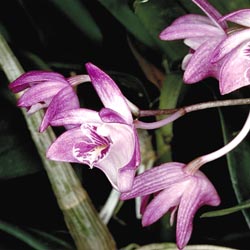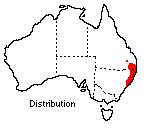Dendrobium kingianum
 |
Also known as Thelychiton kingianus
Pink Rock Orchid
Dendrobium kingianum Bidwill ex Lindl.
Thelychiton kingianus (Bidwill ex Lindl.) M.A.Clem. & D.L.Jones
Dendrobium kingianum occurs naturally in an area along the east coast of Australia between Rockhampton in Queensland and the Hunter River in New SouthWales. It grows exclusively on rock faces or among the decaying leaf litter in rock crevices.
 A
member of the second largest genus of orchids in the world, this Australian
representative is well known overseas and has been cultivated for a number of
years by many botanic gardens and orchid enthusiasts in Europe and North America.
A
member of the second largest genus of orchids in the world, this Australian
representative is well known overseas and has been cultivated for a number of
years by many botanic gardens and orchid enthusiasts in Europe and North America.
The nature of this plant lends itself to cultivation. It is a hardy plant often found growing on exposed cliff faces where it is subjected to direct sunlight and extreme heat radiated from the host rock surface. It may also be without water for months at a time. However, the thick canes (pseudobulbs) act as a store and enable the plant to survive these periods of stress.
The spongy roots have adapted well to these conditions. They quickly absorb moisture and nutrients when these are available and as a result small amounts of rainfall and even dew are useful to the plant. During dry periods the roots remain viable and being white in colour reflect some heat. All these adaptive mechanisms enable the plant to survive in a seemingly hostile environment.
There are many colour forms of the flowers of this species. The normal colour is pink, but pure white and almost red forms are not uncommon.
The flowering season in Canberra is from August to October. Each flower spike has from one to twelve flowers spaced evenly along the short spike (5 - 20 cm long). The spikes are terminal to the canes and in most cases are held erect. They contrast well with the deep green, leathery foliage.
At the Australian National Botanic Gardens this plant has been grown successfully for years, both out of doors and in glasshouses, although the latter is preferred. Frosts and generally low temperatures during the winter months make outdoor cultivation difficult, though not impossible, in a sheltered but sunny bush-house or fernery. The plants do well in pots 10 - 15 cm in diameter in a mixture of woodchips and charcoal (not soil). They should be fertilised fortnightly with a liquid organic fertiliser and watered regularly during their growing period, which lasts from August to March.
Aphids and thrip cause the most damage - they attack the flower spikes and are constant pests that need to be watched. Red mites attack the leaves leaving them scarred and brown in colour. These pests are easily eradicated by normal applications of the appropriate pesticide. Finally, these plants are protected by law and should not be removed from their natural habitat. They are, however, easily obtained from most orchid nurseries.
Text by M. A. Clements (1979)
Name meaning: Dendrobium kingianumDendrobium - from the Greek, dendron, meaning a tree, and bios, life; the species are epiphytes; kingianum - after P.P. King (1 791-1856), an Australian rear admiral in the British Navy and an explorer. |
![An Australian Government Initiative [logo]](/images/austgovt_brown_90px.gif)

